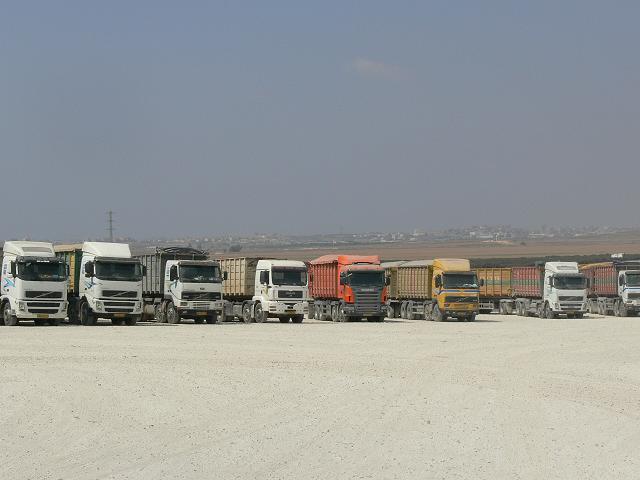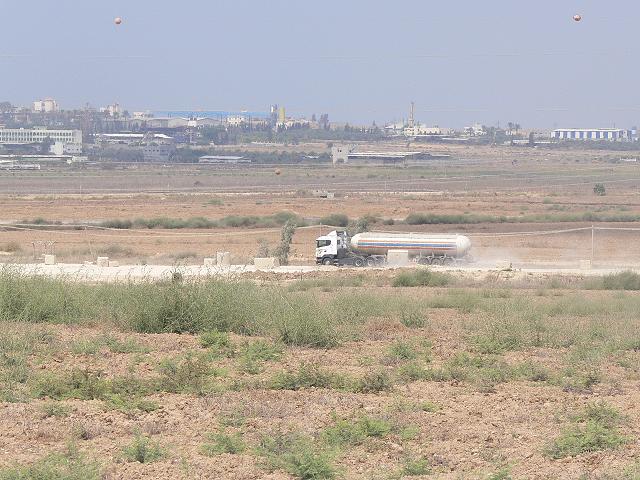The year 2009 brought about a fresh wave of anti-Israel rhetoric and accusations, most which cited Israel’s supposed siege on Gaza. The international press frequently cited calls by human rights groups to “end Israel’s illegal blockade” and “liberate Gaza.” Such messages have been conceived to undermine Israel and present a very misleading angle of the actual Gaza conflict.
In a typical blockade, no supplies would be allowed to enter into enemy territory, or any area of land where the controlling regime facilitates the terrorizing of a neighboring country’s citizens. Most English dictionaries define siege as an “act or process of surrounding and attacking a fortified place in such a way as to isolate it from help and supplies…”
Aid trucks ready to enter the Gaza Strip in the background. (Photo: Jacob Shrybman/Sderot Media Center)
Indeed, the Ministry of Foreign Affairs’ website has reported that in the year 2009 alone, Israel allowed for 703, 224 tons of humanitarian aid and 105,600,128 liters of fuel to be delivered into the Gaza Strip following Operation Cast Lead.
“The IDF invested major resources to enable the flow of humanitarian aid to the Gaza Strip” stated Col. Moshe Levi, the head of the IDF’s Gaza Coordination and Liaison Administration, in November 2009. According to Levi, humanitarian aid to the Gaza Strip increased by 900 percent compared to the previous year. Over 22, 893 humanitarian aid trucks entered into Gaza throughout 2009.
Most recently, the Gaza Freedom March illustrated the way in which pro-Palestinian organizations and left-wing groups were able to utilize the international press and media to communicate their Gaza narrative using the ‘blockade’ and ‘seige’ narrative. Organized by US’s Code Pink’s co-founder, Medea Benjamin, who also happens to be Jewish, the Gaza Freedom March received worldwide media attention as protestors set to break the siege on Gaza.
The march was able to attract some well-known celebrities like Roger Walters of Pink Floyd and American novelist, Alice Walker. But it was not the support of these two celebrities and others like them that attracted the attention of the press. The Gaza Freedom March organizers very cleverly had Hedy Epstein, an 85-year old Holocaust survivor, and Palestinian activist, put in the spotlight for their cause. When Epstein declared a hunger strike to support the Gaza Freedom March, she became an instant international poster girl for the march and made headlines across the world.
In its reports about the Gaza Freedom March, the United State’s Huffington Post site quoted Epstein explaining her support for the Palestinians, as “…everything is due to the Holocaust. But Israel is not being persecuted now. Israel is now the persecutor.”
Unfortunately, those who support the Gaza Freedom March and Palestinian rights, like Hedy Epstein and Medea Benjamin vigilantly disregard the other side of the Mideast conflict-that Operation Cast Lead took place to stop the thousands of Gaza rockets striking Israeli schools, playgrounds, homes and communities each year. Even more absurd, is the way such groups ignore Israeli policies that are set to ensure Palestinians’ access to humanitarian aid and goods, despite the fact that Palestinian terror attacks continue on the Israeli border crossings where these goods pass through.
The original intention of the Gaza Freedom March protestors was to demonstrate that Israel was the sole factor behind the hardship of the Palestinians in Gaza. Inadvertently, the Gaza Freedom March actually brought to light the siege-like policies of Hamas, the extremist Islamic regime that took over Gaza in 2007.
Haaretz reported in an article, Pro-Gaza activists under siege-imposed by Egypt and Hamas, (January 8, 2010), that the Hamas government prohibited Gaza residents from providing lodgings to several hundred international protestors. According to the article, “tough, Hamas security men,” accompanied the peaceful activists during their visit to Gaza and blocked them from speaking with ordinary Gazan residents.
Fuel truck entering the Gaza Strip. (Photo: Jacob Shrybman/Sderot Media Center)
“The march turned into nothing more than a ritual, an opportunity for Hamas cabinet ministers to get decent media coverage in the company of Western demonstrators. Hamas hijacked the initiative and we gave in,” said one protestor in the article.
There were barely any Palestinians who took part in the Gaza Freedom March, and absolutely no Palestinian women. Italian photojournalist, Anna Selini, who documented the march visited Sderot Media Center after her visit to Gaza, and stated that most of the marchers were international supporters. “Hamas did not encourage, even discouraged local people from participating.”
Activists got the impression that “non-Hamas residents live in fear, and are afraid to speak or identify themselves by name.”(Ha’aretz, January 8, 2010).
This is not surprising considering that in December 2008, the Hamas parliament sanctioned the Islamic Sharia law into the Palestinian judicial system. Hamas punishishments for Palestinian offenders include whipping, severing hands (for stealing,) crucifixion and even hanging.
Indeed, there may have been a few people among the 1,300 international protestors, who realized that their message of freedom for Gaza –would have been far more effective had it been directed towards Hamas.
Also see: http://www.ynetnews.com/articles/0,7340,L-3835929,00.html.












